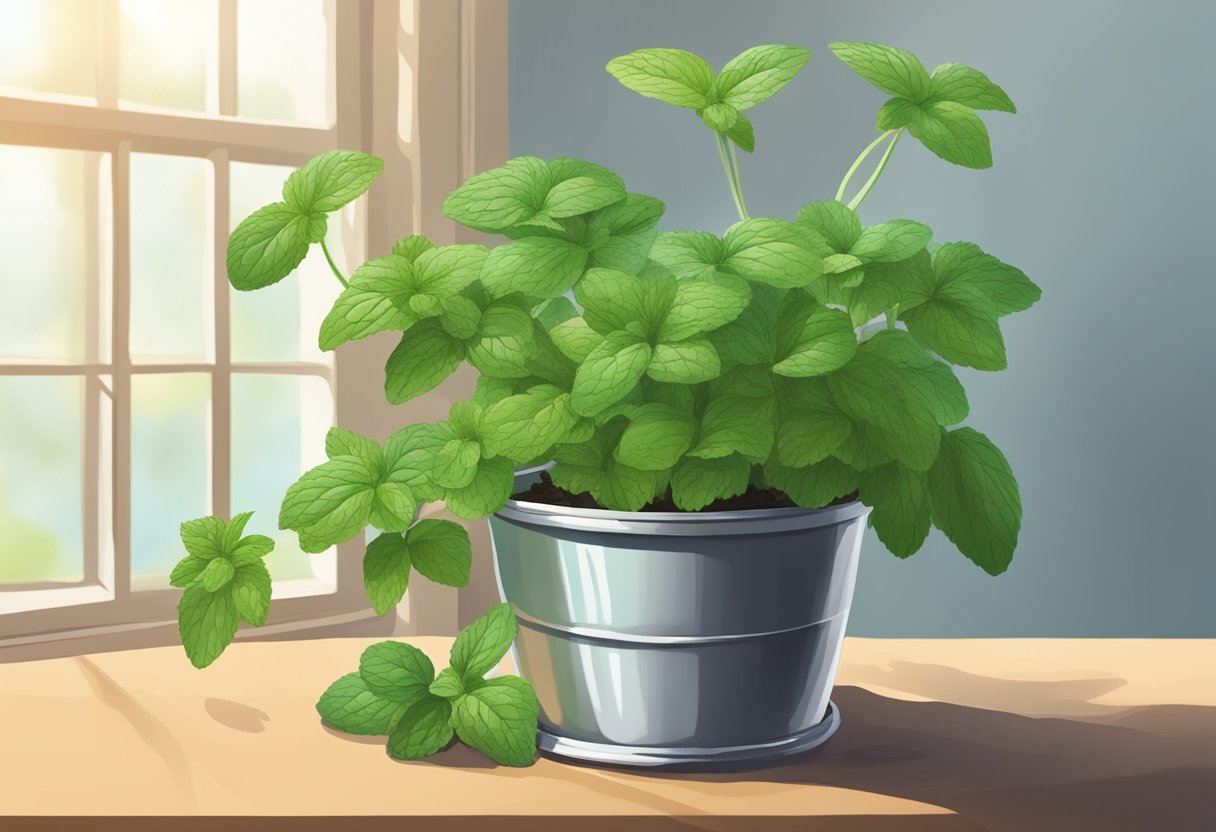Mint plants are a resilient and versatile addition to any home garden or kitchen windowsill, known for their rapid growth and vibrant flavor. These refreshing herbs, however, do require certain conditions to thrive. Consistently moist soil is paramount to maintaining a healthy mint plant; their preference leans towards soil that is never too dry but also avoids being waterlogged to prevent root rot.

A routine check for proper hydration will ensure the plant’s longevity. Equally important to mint care is the provision of adequate indirect lighting. Direct sunlight can harm the delicate leaves, while subdued indirect light will promote steady growth. Managing these two key factors—moisture and light—can lead to lush foliage ready to be harvested for refreshing culinary use.
Additionally, mint thrives in a stable environment with temperatures ranging from 65℉ to 75℉. It’s crucial to shelter these tender herbs from extreme temperature fluctuations that can occur near windows or in proximity to appliances. The moderate room temperature not only sustains a thriving mint plant but also helps to avert potential stress, which can impede growth and decrease the vigor of the plant. With these nurturing efforts, a mint plant can bring both greenery and zest to your living space.
JUMP TO TOPIC
Cultivating a Lush Mint Garden
Achieving a flourishing mint garden involves selecting suitable varieties, providing appropriate soil conditions, and ensuring correct sunlight exposure and location.
Choosing the Right Varieties of Mint
In my experience, mint varieties like spearmint, peppermint, chocolate mint, apple mint, and pineapple mint each have unique flavors and growth habits. It’s crucial to choose the right mint variety that fits your garden space and taste preferences.
- Spearmint: Ideal for culinary use; less aggressive than peppermint.
- Peppermint: Stronger flavor; can be invasive.
- Chocolate Mint: Offers a subtle chocolate scent; a delightful addition to desserts.
- Apple Mint: Provides a milder mint flavor with a hint of fruitiness.
- Pineapple Mint: Features a tropical twist; attractive variegated leaves.
Planting and Soil Preferences
Mint thrives in rich, moist soil that is well-draining. I always work in some compost to enrich the soil before planting. Planting in a container can prevent mint from overtaking the garden.
- Soil Composition: Loamy soil with good organic matter content.
- Drainage: Essential to avoid waterlogging the roots.
- Compost: Incorporate into the planting hole for nutrient-rich soil.
Sunlight and Location Considerations
Although mint is adaptable, I find it performs best with ample light and some protection from the hottest sun. Mint can tolerate partial shade, especially in climates with intense sunlight.
Mint requires 4-6 hours of sunlight per day. It can grow in full sun to partial shade conditions. Choosing a location that provides morning sunlight and afternoon shade can prevent scorching in hotter regions.
Essentials of Mint Plant Care
Mint is a tenacious and fragrant herb that thrives with the right balance of water, protection from pests, and soil nutrients. I’ll share my best practices to ensure your mint plants stay healthy and vibrant.
Watering and Moisture Management
Maintaining proper moisture levels is crucial for mint plants. They prefer evenly moist soil, but it’s vital to avoid overwatering which can cause root rot. Here’s how I manage moisture:
- Check the top inch of soil: If it’s dry, it’s time to water.
- Water deeply: This encourages robust root systems.
- Drainage is key: Ensure pots have holes to prevent waterlogging.
Dealing with Pests and Diseases
Mint can attract pests like aphids and spider mites, but also suffers from diseases like mildew. I adopt the following measures to combat these issues:
- Regular inspections: Catching pests early is half the battle.
- Neem oil: An organic solution for pest control.
- Air circulation: Good airflow helps prevent mildew.
Fertilizing and Mulching Strategies
Fertilizer supports growth, while mulch conserves moisture and suppresses weeds. Here is my approach:
- Use a balanced fertilizer: Apply in the growing season for robust plants.
- Mulching: Organic mulch keeps roots moist and cool.
Proper care of mint involves consistent attention to water, vigilance against pests and diseases, and the use of fertilizer and mulch to support healthy growth. These strategies have proven successful in my own garden, and I’m confident they will serve you well too.
Harvesting and Utilizing Mint
Mint is a versatile herb that can enhance a multitude of dishes and beverages. Proper harvesting and storage techniques are key to preserving its vibrant flavor and ensuring a continuous supply.
Pruning and Harvesting Techniques
💥 Pruning for Growth
When I harvest mint, it’s important to promote healthy plant growth and maintain a good supply of leaves. I make sure to:
- Prune regularly, as mint grows quickly and responds well to cutting.
- Cut stems down to about 5 inches, which encourages bushier growth and prevents the plant from getting leggy.
– Use sharp shears to make clean cuts.
– Harvest in the morning when the essential oils are strongest for the best flavor.
Storing and Preserving Mint Leaves
Proper storage of mint leaves ensures I can enjoy their flavor year-round. Here’s how I keep mint fresh:
| Dried Mint | Frozen Mint |
|---|---|
| Dry leaves by hanging stems upside down in a dark, well-ventilated area. | Freeze whole leaves or chopped mint in ice cube trays covered with water. |
Storage Duration: Dry mint can last up to a year, while frozen mint is best used within six months.
Culinary and Other Uses of Mint
Mint brings a burst of freshness to various culinary creations. In my kitchen, mint is a staple for:
- Sprucing up salads with its cool, crisp flavor.
- Enhancing cocktails, like mojitos, with its vibrant taste and aroma.
- Adding a refreshing twist to teas, both hot and iced.
Mint is not just for eating—its aroma is also used in homemade potpourris and as a natural air freshener. When I use mint, its invigorating scent and taste can transform an ordinary recipe into something extraordinary.












